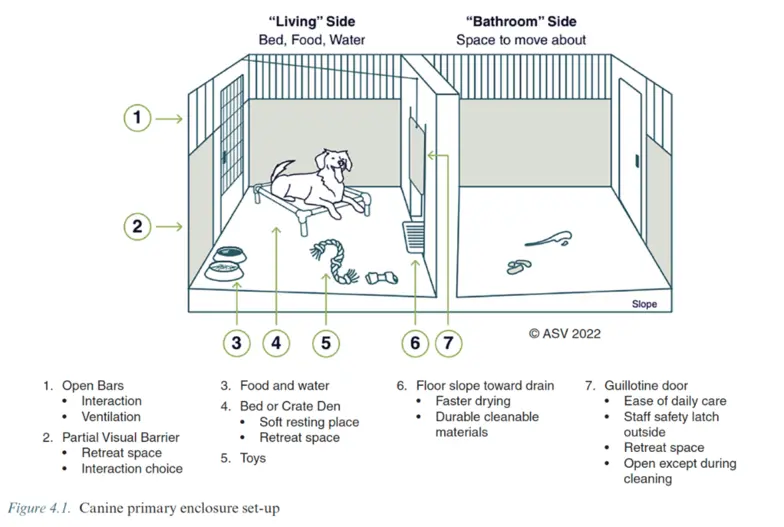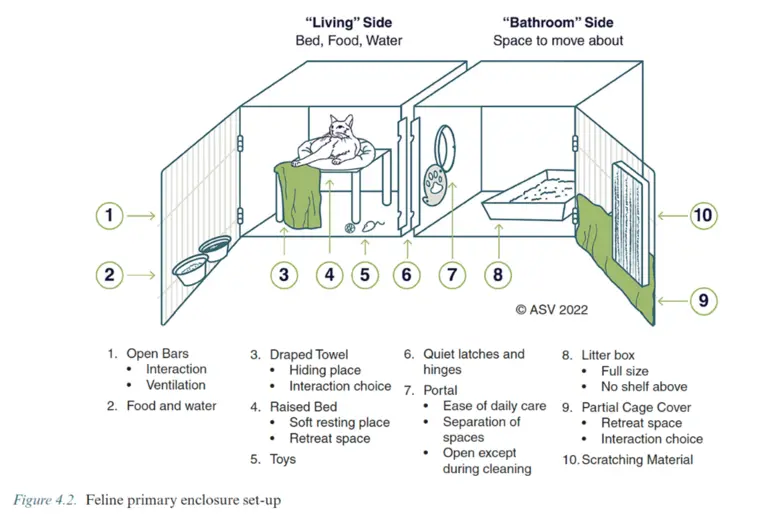Animal Housing in Shelters: Primary Enclosures, Kennels, Cages & Rooms
Humane housing in animal shelters is a challenge and includes both the macro- and micro-environments of housing areas.
- The macroenvironment consists of the various factors outside primary enclosures, including room design, air quality, temperature, noise, stressful stimuli, lighting cycles and interactions with humans and other animals.
- The microenvironment includes the size, quality and set-up of primary enclosures and individual fluctuations in aspects of the macroenvironment.
When evaluating how animals experience their environment in the shelter, optimizing elements of both the macro- and micro- environments are critical to ensuring humane care.
Expectations for humane housing for dogs and cats (and rabbits) have undergone a profound shift in animal shelters, including the creation of guidelines for minimal space allocations and set-ups. When shelter stays extend beyond short term (i.e., longer than 2 weeks), additional housing requirements include increased space and enrichment as well as more time outside of primary enclosures.
Adding portals or pass-through kennel doors to turn single-compartment housing into multiple-compartment units is one of the most important shelter renovations to improve animal health and well-being in shelters. When combined with strategies like intake diversion and daily rounds, shelters can improve health and welfare while also reducing length of stay and overall animal population numbers.
Primary Enclosures
A primary enclosure is where an animal spends most of their time in a shelter, like a cage, kennel or room. These enclosures must be the right size, made from suitable materials and set up properly to meet the animal's needs.
Shelters should offer different types of enclosures for each species to address their health and behavior. Primary enclosures must provide adequate space as well as complexity and choice to support natural movement and behaviors during confinement in the shelter. Enclosures with separate areas for eating, resting and eliminating waste are ideal, especially if the animal stays in the shelter for a long time.
The ASV Guidelines demonstrate the layout and set-up for multiple-compartment housing and show how well-designed enclosures support the health and well-being of animals.


Primary enclosures are improved with daily enrichment items and features that give animals choice and control, like elevated beds or places to hide. Shelters can purchase these items, or enroll crafty staff and volunteers in building them, as demonstrated in this Makers Guide to DIY Housing Accessories for Animal Shelters, 2nd Ed.
Certain enclosures, like travel crates or those with wire bottoms, are not suitable for dogs and cats in shelters. Need help assessing your shelter’s enclosures? Check out this Primary Enclosures Checklist from the ASV Guidelines for Standards of Care in Animal Shelters.
Looking to co-house animals? See Co-housing Recommendations.
Enclosure images are from Journal of Shelter Medicine and Community Animal Health, Vol. 1 No. S1 (2022)
Additional Resources & Downloads
Downloads
Download AllWe have lots more on this subject:

